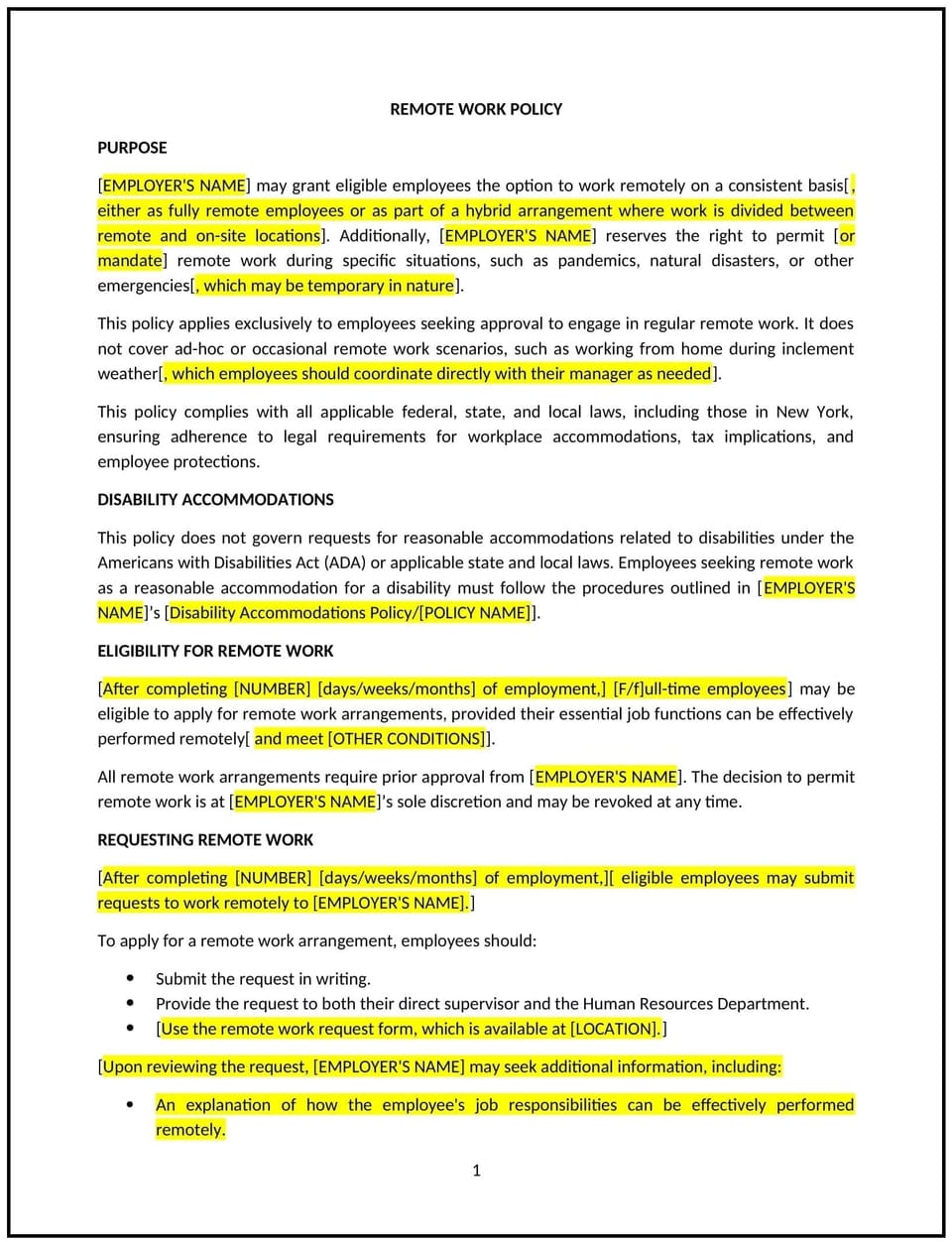Remote work policy (New York): Free template

Remote work policy (New York)
This remote work policy is designed to help New York businesses establish clear guidelines for employees who work remotely. Whether businesses are offering full-time remote work, hybrid schedules, or occasional work-from-home opportunities, this template provides a structured approach to managing remote work arrangements while maintaining productivity and accountability.
By adopting this template, businesses can create a flexible work environment, improve employee satisfaction, and ensure consistent operations, even when working remotely.
How to use this remote work policy (New York)
- Define remote work eligibility: Clearly outline which employees are eligible for remote work, including any criteria such as job function, performance, or tenure.
- Specify work hours: Set clear expectations for work hours, availability, and communication, ensuring employees remain accessible during business hours while working remotely.
- Establish remote work expectations: Include guidelines on productivity, reporting, collaboration tools, and performance metrics to ensure remote work does not affect business outcomes.
- Address technology and security: Provide instructions for remote work setups, including any necessary technology (e.g., laptops, software) and security measures (e.g., VPNs, data protection).
- Outline communication protocols: Specify how employees should communicate while working remotely, such as regular check-ins, meetings, and using company communication tools.
Benefits of using this remote work policy (New York)
This policy offers several benefits for New York businesses:
- Increases flexibility: Clear guidelines on remote work options provide employees with more flexibility, improving work-life balance and job satisfaction.
- Enhances productivity: Establishing remote work expectations ensures that employees remain focused and accountable, maintaining productivity even outside the office.
- Supports employee retention: Offering remote work options is a valuable perk that can help retain top talent and reduce turnover.
- Reduces operational costs: Remote work can reduce office space and operational costs, such as utilities and office supplies.
- Promotes work-life balance: Remote work supports a healthier work-life balance, which can improve employee engagement and overall well-being.
Tips for using this remote work policy (New York)
- Communicate clearly: Ensure all employees are aware of the policy and understand the expectations for remote work, including hours, productivity, and communication requirements.
- Use the right technology: Provide employees with the necessary technology and tools to perform their work remotely, such as laptops, VPN access, and collaboration software.
- Monitor performance: Track remote employees’ performance and productivity using established metrics and regular check-ins to ensure that remote work is effective.
- Foster collaboration: Encourage frequent communication and collaboration among remote employees through virtual meetings, chats, and shared workspaces.
- Review regularly: Update the policy as necessary to reflect changes in business needs, employee feedback, or New York state regulations.
Q: What should businesses consider when determining eligibility for remote work?
A: Businesses should consider the nature of the role, employee performance, job responsibilities, and company operational needs when determining eligibility for remote work.
Q: How can businesses track productivity and performance for remote workers?
A: Businesses can track productivity and performance by setting clear expectations, using project management tools, monitoring key performance indicators, and conducting regular check-ins to ensure remote work remains productive.
Q: What security measures should businesses implement for remote work?
A: Businesses should implement VPNs, use encrypted communication channels, enforce strong password protocols, and regularly update security software to ensure the safety of company data and systems when employees are working remotely.
Q: How can businesses maintain effective communication with remote employees?
A: Businesses can maintain effective communication by establishing clear protocols for regular check-ins, using collaboration tools, setting expectations for responsiveness, and ensuring that all employees are included in key meetings and updates.
Q: How often should businesses review and update their remote work policy?
A: Businesses should review their remote work policy annually or whenever significant changes occur in technology, employee needs, business objectives, or New York state regulations.
This article contains general legal information and does not contain legal advice. Cobrief is not a law firm or a substitute for an attorney or law firm. The law is complex and changes often. For legal advice, please ask a lawyer.


